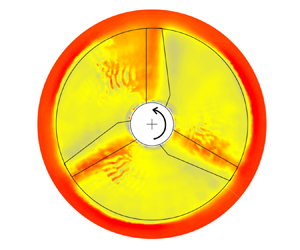Article contents
On the relationship between turbine thrust and near-wake velocity and vorticity
Published online by Cambridge University Press: 29 September 2022
Abstract

Vortical impulse theory is used to investigate the relationship between turbine thrust and the near-wake velocity and vorticity fields. Three different hypotheses regarding the near-wake structure allow the derivation of novel expressions for the thrust on a steadily rotating wind turbine, and these are tested using stereoscopic particle-image velocimetry (PIV) data acquired just behind a rotor in a water channel. When one assumes that vortex lines and streamlines are aligned in a rotor-fixed frame of reference, one obtains a PIV-based thrust estimate that fails even to capture the trend of the directly measured thrust, and this failure is attributed to an implicit assumption that most of the generated thrust does useful work. When one neglects the axial gradients of radial velocity, the PIV-based thrust estimate captures the measured thrust trend, but underpredicts its magnitude by approximately  $33\,\%$. The third and most promising physical proposition treats the trailing vortices as purely ‘rolling’ structures that exhibit zero-strain rate in their cores, with the corresponding thrust estimates in close agreement with direct thrust measurements. This best-performing expression appears as a correction to the classical thrust expression from momentum theory, possessing additional squared-velocity terms that can account for the high-thrust regime of turbine operation that is typically addressed empirically.
$33\,\%$. The third and most promising physical proposition treats the trailing vortices as purely ‘rolling’ structures that exhibit zero-strain rate in their cores, with the corresponding thrust estimates in close agreement with direct thrust measurements. This best-performing expression appears as a correction to the classical thrust expression from momentum theory, possessing additional squared-velocity terms that can account for the high-thrust regime of turbine operation that is typically addressed empirically.
JFM classification
Information
- Type
- JFM Papers
- Information
- Copyright
- © The Author(s), 2022. Published by Cambridge University Press
References
REFERENCES
- 5
- Cited by


